
Share
AMERICANMUSHROOMS.COM SITE INDEX
about • mushroom basics • coolest mushrooms • edible mushrooms •
1,046 mushroom photos! • HOME • lawn & garden mushrooms • mushroom links • medicinal mushrooms
morel mushrooms • mushroom I.D. • mushroom photography • mushroom show • music • mushroom odors • psilocybin mushrooms • schedule • store • tiniest mushrooms • toxic mushrooms
David Fischer's
Mushroom Photo Gallery
Indexes of Scientific Names
Click here to access the Index of Common Names
1,046 incredible photos of mushrooms and other fungi!
Special thanks to Paula DeSanto, whose contributions add a lot to this resource!
IMPORTANT NOTE
Please note that this resource is posted without warranty as to absolute taxonomic determination. In other words, it is possible that I have mislabelled a mushroom here! I am always grateful for corrections (contact me at mycology@aol.com).
DO NOT use these photos as a tool for safe identification of edible wild mushrooms—use resources that are designed for that purpose:
Edible Wild Mushrooms of North America
America's Best, Safest Edible Wild Mushrooms
Click on any of the below groups of mushrooms to access the indexes, which include thumbnail photos.
BASIDIOMYCETES (Mushrooms)
This group includes the bulk of the conspicuous mushrooms. I have divided them into 12 subgroups that are based more on what they look than on their scientific classifications.
Agarics (Gilled Mushrooms)



Most GILLED MUSHROOMS are fleshy and have caps supported by a central stalk, but some that grow on wood are stalkless and may appear more shelflike. The majority are terrestrial. The key feature is the layer of flat-sided gills on the undersurface of the cap. The gills radiate (like the spokes of a wheel) toward the edge of the cap from the stalk (or, in the case of stalkless species, from the point of attachment to the dead wood on which they grow). Size varies tremendously, from tiny mushrooms with caps no more than 1/8" wide to really big ones with caps the size of dinner plates.
Chanterelles and Similar Mushrooms



CHANTERELLES are often mistaken for true gilled mushrooms (agarics), but the "gills" of chanterelles are blunt, forked, and crossveined (not thin and flat-sided like true gills), and many species lack anything that resemble gills. These mushrooms are all fleshy, and most are popular edibles. A number of these mushrooms are trumpet- or vase-shaped, including the BLACK TRUMPET.
Boletes



BOLETES are fleshy, terrestrial cap-and-stalk mushrooms but instead of gills beneath their caps, they have a layer of downward-pointing tubes. When you look beneath the cap you see the open ends of those tubes, which make it appear rather like a sponge.
Polypores



POLYPORES are typically leathery or woody, though a small number of species are fleshy enough that they are among the most popular edibles. Often called bracket fungi or shelf mushrooms, polypores only grow on or from wood (sometimes from buried wood or dead tree roots). As with boletes, there is a layer of tubes beneath each cap, although sometimes the pores are so tiny that they are difficult to see without a magnifying lens. Many are shelflike, but some are umbrelloid in shape and a few appear more like bushes.
Puffballs, Stalked Puffballs, False Puffballs and Earthstar Mushrooms

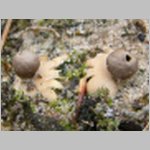
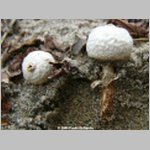
PUFFBALLS are generally spherical (some species have sterile stalks and hence are shaped more like upside-down pears) and vary from just a couple inches in diameter to, in some instances, several feet in diameter. At maturity, the entire interior of the puffball is a powdery mass of spores. Most puffballs are edible, though caution is advised to rule out button-stage Amanitas (which can be deadly!) and FALSE PUFFBALLS (which can cause gastronitestinal illness). EARTHSTAR MUSHROOMS are essentially puffballs with starlike rays radiating away from the spore case.
Stinkhorns
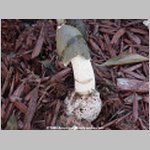
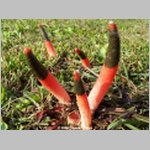

STINKHORNS have a bizarre variety of shapes, but most often are phallic in shape or have "arms" that resemble tentacles. Many are quite colorful, and they are common in gardens and on lawns. Most species emit a very foul odor, which is designed to attract flies (to help spread the spores).
Bird's-nest Mushrooms and Sphaerobolus

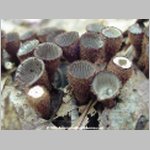
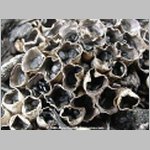
BIRD'S-NEST MUSHROOMS are tiny and are generally overlooked, although patches of hundreds or thousands of them are common in garden mulchbeds. Sphaerobolus is quite similar.
Coral Mushrooms



Most CORAL MUSHROOMS either closely resemble marine coral or grow in clumps of slender "fingers." A few species are more club-shaped. Some species grow on wood, but most are terrestrial.
Some Jelly Mushrooms resemble corals, so that group should also be checked if you're having a difficult time identifying a mushroom that resembles coral.
Tooth Mushrooms



Sometimes TOOTH MUSHROOMS are confused with coral mushrooms, but the difference is simple: "teeth" point down, while coral mushrooms point up. Some are terrestrial, umbrellalike cap-and-stalk mushrooms… others grow only on wood.
Jelly Mushrooms

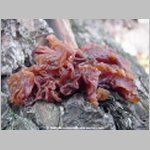

Most JELLY MUSHROOMS are distinctly gelatinous but some are less so, often resembling coral mushrooms. Note that some Ascomycetes are also distinctly gelatinous, so check that group if you're having difficulty finding your mushroom here.
Crust Mushrooms and Parchment Mushrooms



This is a difficult group to characterize! See the photos to get a better sense of which mushrooms I have lumped together in this group.
Miscellaneous Basidiomycetes


This group comprises an assortment of basidiomycete mushrooms that do not fit in other categories.
ASCOMYCETES (Mushrooms)
This group includes a wide variety of forms including morels, false morels and many others. Here they are divided into four subgroups.
Cup and Disk Mushrooms

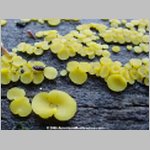
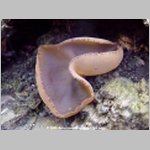
These are disk-shaped to cup-shaped, with or without stalks. Most are small and drab, but some are very colorful and can be several inches in width.
Morels and False Morels
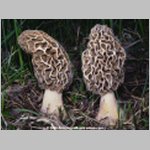
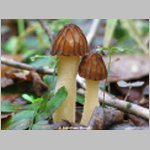
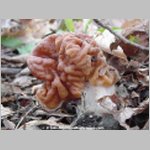
Morels have caps that resemble honeycombs, with pits surrounding ridges, and are entirely hollow from top to bottom; False Morels (Gyromitras) are shaped more like brains.
Hypomyces
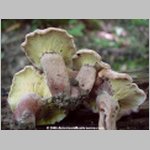
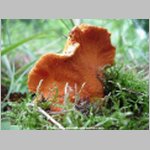
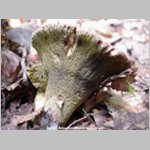
These are a distinct group of Ascomycetes that parasitize other mushrooms, deforming them and giving them a rough sandpaper-like coating.
Other Ascomycetes
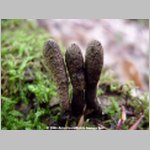

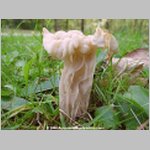
Many of these are shaped like cylinders, clubs, tongues or fans, but the forms vary widely.
ZYGOMYCETES
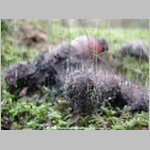
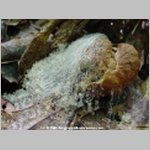
Very few species are likely to be noticed by mushroom enthusiasts.
HYPHOMYCETES
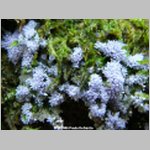
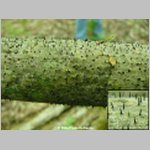
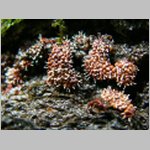
These are molds, which are asexual. Only a few species—primarily the asexual states of various ascomycetes—are of much interest to most amateur mycologists.
MYXOMYCETES (Slime Molds)

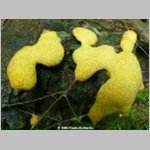

Slime molds are mostly TINY and are not often noticed unless you are seeking them. The Scrambled-egg Slime Mold (center photo above) is common in gardens, on lawns, in wood-chip mulch, and other suburban locations. Like only a few common woodland species, it can cover an area of several square feet. Slime molds are actually not fungi (they're more closely related to amoebas!) but they do produce spores and many mycologists continue to study them.
AMERICANMUSHROOMS.COM SITE INDEX
about • mushroom basics • coolest mushrooms • edible mushrooms •
1,046 mushroom photos! • HOME • lawn & garden mushrooms • mushroom links • medicinal mushrooms
morel mushrooms • mushroom I.D. • mushroom photography • mushroom show • music • mushroom odors • psilocybin mushrooms • schedule • store • tiniest mushrooms • toxic mushrooms
To contact David Fischer or submit a mushroom photo
for identification assistance, "Like" the AmericanMushrooms.com
Facebook Page
Copyright © 2006, 2018 by David W. Fischer. All rights reserved.